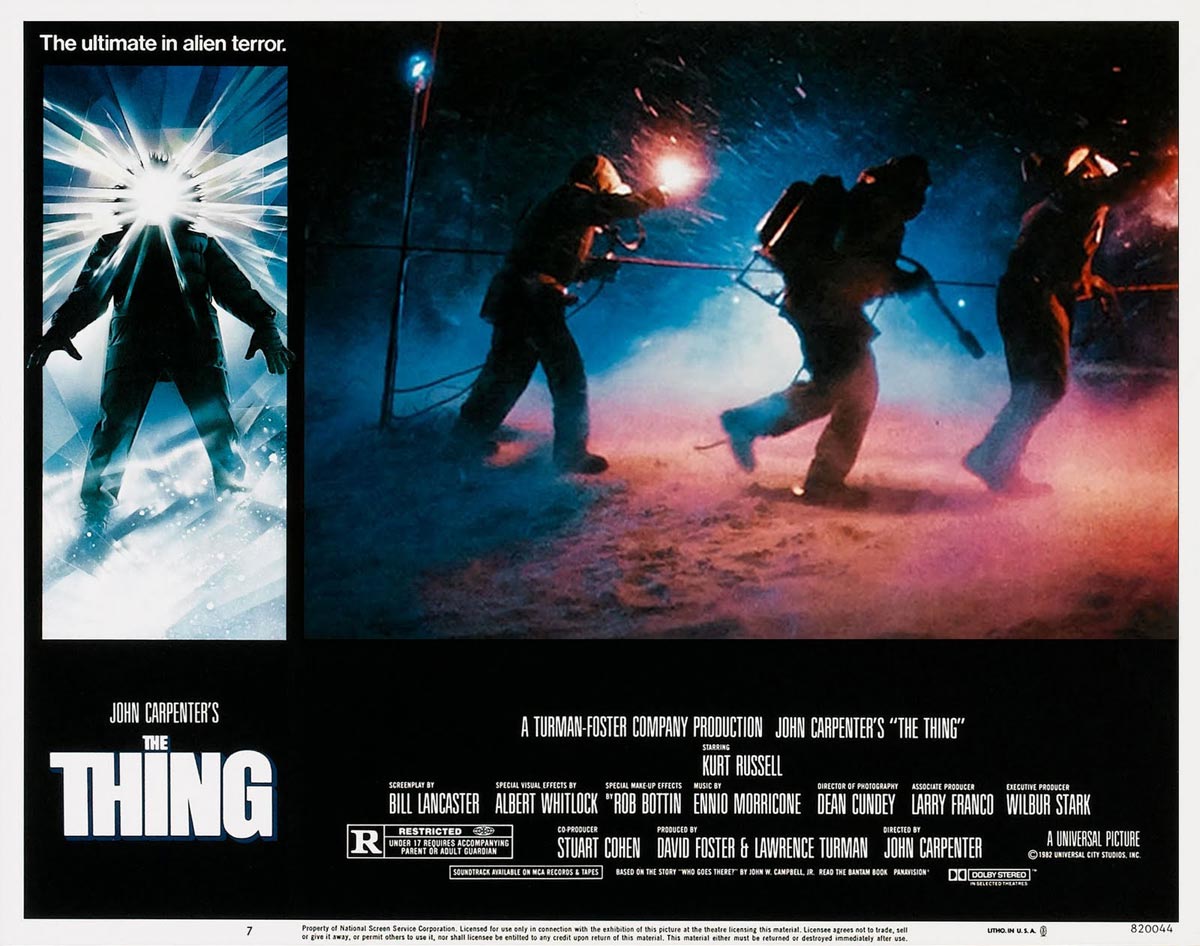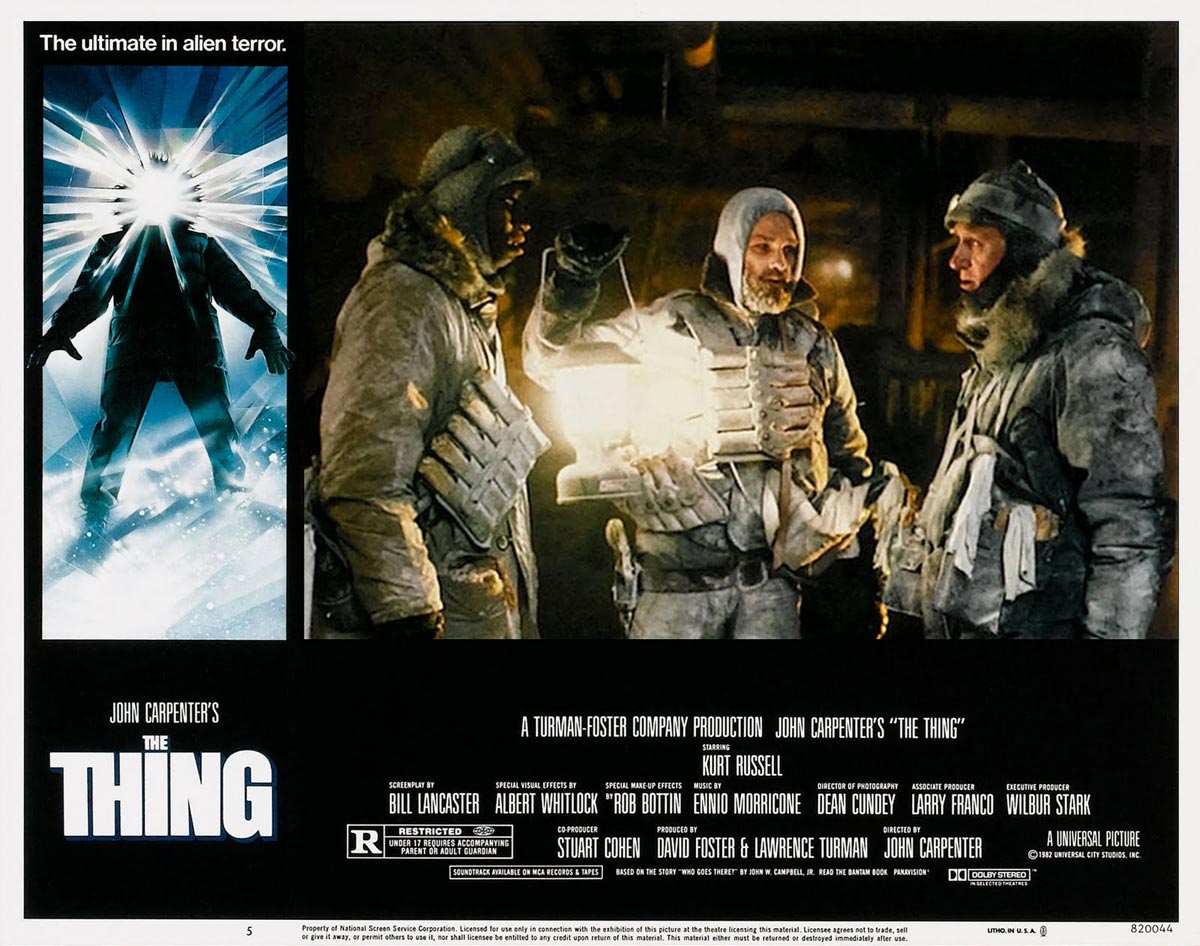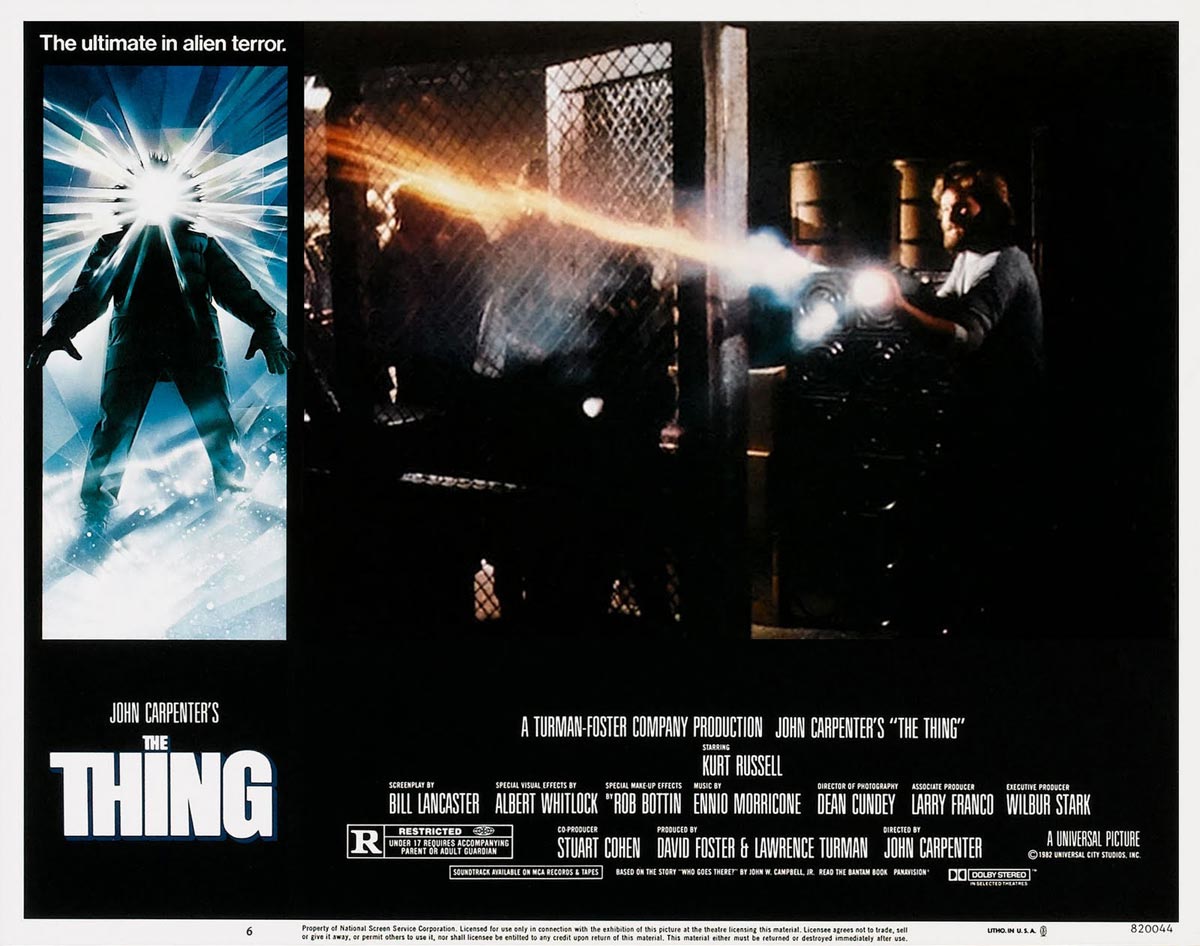“I know I’m human. And if you were all these things, then you’d just attack me right now, so some of you are still human. This thing doesn’t want to show itself, it wants to hide inside an imitation. It’ll fight if it has to, but it’s vulnerable out in the open. If it takes us over, then it has no more enemies, nobody left to kill it. And then it’s won.” – MacReady (Kurt Russell)
There are many scenes in John Carpenter’s masterpiece The Thing that make me feel, not just scared, but a chill deep in my heart – intensifying the icy environs these unfortunate men are surrounded by; permeating the picture with unexplainable horror and an all-consuming paranoia. A paranoia these men don’t want to feel for one another. Anxiety, distrust, death. But there’s one early, chilling scene that could have played it quite simple – it’s a character reading from notes. You’ve watched scenes like this in movies before and either, they explain too much and you listen to the necessary information, with a yes, yes, I get it, or they’re merely easy exposition. This is what is happening, audience, they say. But the way Carpenter times the reading, and the way he shoots it, in such an enclosed space, the cold whirring outside, and the way the actors react to each other, one alarmed and warning, the other annoyed, tired and then … concerned, it’s both powerfully scary and, really, extraordinarily sad. Dear god, what are these men going to do?

It’s when R.J. MacReady (a magnificent Kurt Russell) sits in the Bombardier Skidozer outside with Fuchs (Joel Polis), after their chief scientist Blair (Wilford Brimley) has gone crazy and locked himself in his room. “There’s something wrong with Blair,” sensitive Fuchs tells an already exasperated MacReady who didn’t want to have this private discussion in the first place. The Skidozer seems the only place they can talk privately away from the outpost – the cold raging outside of them while the men deal with a body in their Antarctica research station (which will already become a doubled-up terror on top of this scene). Fuchs continues, “He’s locked himself in his room and he won’t answer the door. So I took one of his notebooks from the lab . . .” MacReady looks over at him with a slightly annoyed, “Yeah?” Fuchs reads from Blair’s notes: “It could have imitated a million life forms on a million planets. It could change into any one of them at any time. Now it wants life forms on earth …” MacReady cuts him off, “It’s getting cold in here Fuchs, and I haven’t slept in two days.” He’s both not wanting to hear this shit and not prepared to hear this shit. But Fuchs persists, “Wait a minute, Mac, wait a minute.” He reads: “It needs to be alone and within close proximity with a life form to be absorbed. The chameleon strikes in the dark …” O.K., at this point, and when I first saw the movie, that scared the hell out of me – that this destructive, all-consuming force needed to be near you, that it was a chameleon, that it sat in wait to strike, and that it comes for you in the dark. This is one of the things you fear as a child, as you close your eyes and hope nothing is hiding under your bed. It’s also the dread of whatever you might fear in a person you don’t trust, or, even more terrifying, what you don’t trust in yourself. It’s anxiety personified.
But MacReady grows further annoyed, “So is Blair cracking up, or what?” he asks. Fuchs then reads with insistence: “There is still cellular activity in these burned remains. They’re not dead yet.” MacReady’s face is leaned to one side looking at Fuchs, Fuchs looking back at him, seriously. MacReady says nothing and yet, he’s saying everything as he looks over – Russell is subtly revelatory and multidimensional in his horror here – he’s fearful, he’s also just beginning to think. The camera, perfectly, shoots the men from outside the Skidozer, further showing how small they are amidst this unrelenting force, this powerful tool will become a useless vehicle – it’s merely a meeting area at this point. And with this, Carpenter lets those words sink in: “They’re not dead yet.” Cut to Windows (Thomas G. Waites), shockingly walking in on a consumed body in the corner, snakelike tendrils wrapping around the thing – what on earth is this creature? “They’re not dead yet.” No, they’re not. And as the movie goes on, we learn they are never going to stop.

It’s that unstoppable dread filmed with beauty and horror (gorgeously shot by cinematographer Dean Cundey – Ennio Morricone’s score is commanding as well) and deliberate pace that makes The Thing so artfully, potently scary and, by the end, both effective and poignant. That this group of isolated men working at this research station in all of their varied positions and personalities (I’ve read some complaints there’s little to distinguish these men and I’ve never understood this critique – you grow to like and care about all of these very distinct guys) are forced into a position of distrust due to this alien, assimilating creature is part of the tragedy. Watching men who work, drink, quip, and lead a rather lonely existence all shoved together out there at that outpost having to turn brother-against-brother while attempting to save themselves or take charge (which MacReady does) ratchets up the intensity, but it also adds depth and nuance to their predicament. The picture never addresses anything obviously, and intriguingly, allegorical ideas abound in The Thing – the idea of being taken over by an ideology, a wave of panic, disease – it’s all there. My fear while watching the movie is the horror of one’s own self, of never-ending anxiety, and how that kind of inner panic might look like when turned inside out.
This is where the brilliant tension mixed with the gore, effects and creature designs (by Rob Bottin) work in perfect, terrifying unison. You’re stressed and maybe even horrified as each new set piece occurs (and each one is beautifully conceived), wondering what on earth the next thing will look like. That the monster is not one unified creature but rather a shape-shifting horror we can never quite place (at one point I stared at a thing like disgusting stalks of vegetables, snakes, teeth, intestines and eyes) that it becomes some kind of personification of the horror inside a person. When we say we feel all “twisted inside” or we can’t breathe from panic or our hands feel like jelly – the most horrifying dread someone like Raskolnikov ever pictured emanating from him. Kafka’s anxious nightmare – you can’t even escape anxiety when stationed in Antarctica and worse WHEN STATIONED IN ANTARCTICA – claustrophobia and snow capped agoraphobia mixed together. I even thought of Edvard Munch’s “The Scream” when observing these creatures, a painting stimulated by intense anxiety and distress in his life. As he wrote of the work’s inspiration:
“I was walking along the road with two friends – the sun was setting – suddenly the sky turned blood red – I paused, feeling exhausted, and leaned on the fence – there was blood and tongues of fire above the blue-black fjord and the city – my friends walked on, and I stood there trembling with anxiety – and I sensed an infinite scream passing through nature.”
What would Munch make of The Thing?
The picture was adapted by Bill Lancaster from John W. Campbell, Jr.’s novella “Who Goes There?” (Also loosely adapted by Howard Hawks for The Thing from Another World) and it’s a fantastical setup that well understands the insanity and panic of the horror. (Carpenter was also inspired by H.P. Lovecraft — The Thing is considered the first part of his “Apocalypse Trilogy,” rounded out by Prince of Darkness and In the Mouth of Madness). Indeed, Carpenter understands the shock and terror so well here that characters stand in near-breathless disbelief and disgust, and, at times, in a darkly comic stupor. Carpenter (and the terrific actors) never make any of these men unaware of how simultaneously terrifying and surreal this all is – there is never a stupid, overly clever quip, or an easily brave move, or a perfectly heroic moment (though there are brave and heroic moments in that these men don’t all run away or, into walls in an insane panic). These men are surviving the best way they can and the humor and humanity come out organically from their predicament. When Norris (Charles Hallahan) turns into that demented spider-like head-creature-thing (I have no other way to describe it) and Palmer says: “You’ve got to be fucking kidding…” it supremely funny because, we are all thinking the same damn thing. And when, near the end of the film’s brilliant centerpiece – the blood test – Gary (Donald Moffat) yells: “I’d rather not spend the rest of the winter TIED TO THIS FUCKING COUCH!” it’s such a simple and honest, yet hilarious thing to holler after everything that has just occurred, that it works as a kind of relief. Sadly, he won’t be tied to that fucking couch – he’ll eventually be dead.
Which leads to the picture’s enigmatic, and in my mind, elegiac, even beautiful ending. Childs (a wonderful Keith David) and MacReady are the last men standing – one of them could be infected. What do they do? Kill each other? No. Turns out, they’ll just have to trust each other – they’ll have to wait and see. That’s damn touching, and, depending on what kind of person you are (I’ll put aside other theories) this could be read as hope for man while hopelessness abounds – a choosing to trust and maybe even love when you’ve got god knows how many days or seconds left to your life, over violence and doubt. As the tagline of the film said – “Man is the Warmest Place to Hide” – that’s true for the soul-sucking creature, yes. But for a human being, warmth and faith are more comforting than leaving your friend out in the cold.



